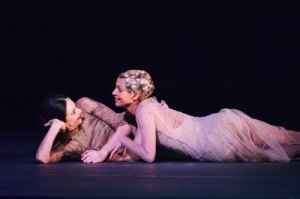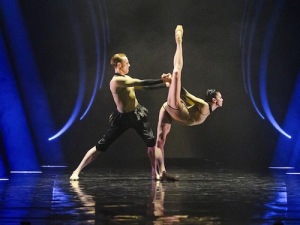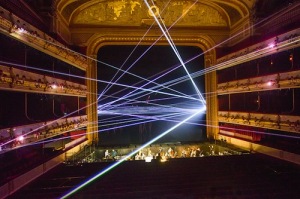An unfailing life
by Mika Provata-Carlone Woolf Works © Tristram Kenton/Royal Opera House” width=”360″ height=”240″>On 29 April 1937 Virginia Woolf read one of her texts on the radio, the only recording of her voice known to have survived from a total of three BBC radio broadcasts. This highly introspective essay on the craftsmanship of writing was entitled ‘Words Fail Me’; four years later, almost to the day, Woolf would make that statement quite final by taking her own life.
Woolf Works © Tristram Kenton/Royal Opera House” width=”360″ height=”240″>On 29 April 1937 Virginia Woolf read one of her texts on the radio, the only recording of her voice known to have survived from a total of three BBC radio broadcasts. This highly introspective essay on the craftsmanship of writing was entitled ‘Words Fail Me’; four years later, almost to the day, Woolf would make that statement quite final by taking her own life.
‘Words Fail Me’ is a text that is both lyrical and provocative, it is written in Woolf’s mesmeric, beautifully emotive and contemplative style, and possesses the celebrated verve and pinching audacity that makes her writing so captivatingly unique. Above all, it possesses the timbre, the inflections and modulations, the highly idiosyncratic articulation and phrasing of Woolf’s voice: its resounding silence, that solitariness that bursts with life, the optimism that defeats its own self-devastation.
The recording lasts roughly 7 minutes, a third of the total length of her scheduled air time. And yet in those 7 or so minutes Woolf unleashes all her powers of enchantment, like a rather regal sorceress standing on a cliff, commanding Macbeth’s raging “multitudinous seas incarnadine” or spinning orderly whirls of meaning out of the vortex of human consciousness. Wayne McGregor and Uzma Hameed’s triptych Woolf Works, currently at the Royal Opera House, hauntingly begins with the first minutes of that recording – with Woolf’s reverberating voice permeating the auditorium, while projected on a screen looms a chaos of symbols lining up into scattered words, gaining momentum and an irrepressible impetus that grants them shape – an iconic black-and-white portrait of Woolf herself, her slightly oblique gaze transfixing us as it beguiles us.
Hesitant posing, gestures and motions remembered with some apparent effort, attempts at a beginning, translate Woolf’s words, pauses, ellipses and cascading paragraphs into truly powerful physical speech.”
On the stage are three wooden frames that stand at an angle, and which will pivot throughout this first section entitled ‘I now, I then’. They possess a linearity and concreteness that enhances their empty core space the elusive tight riggings of Woolf’s own narratives. They will hide, reveal, offer structure and protection – or expose the dancers/characters to a menacing monumentality. They could be frames of vision, the physical frames of Woolf’s novels, windows into the human psyche or the means of egress from a state of mind, a stage in one’s life, a world both determined and disoriented. In the background stands Alessadra Ferri as Clarissa Dalloway, while around her flicker scenes from 1930s London. Hesitant posing, gestures and motions remembered with some apparent effort, attempts at a beginning, translate Woolf’s words, pauses, ellipses and cascading paragraphs into truly powerful physical speech, and Ferri dances as much with her peerlessly expressive face as she does with her feet, body and arms. Soon she ‘becomes’ two, as Clarissa’s alter ego, her younger self, also shadow dances the text, the two coexisting in their private narrative and mythography, just as a superbly tragic and heroic Septimus Smith (Edward Watson) makes his appearance with his Italian wife, Lucrezia ‘Rezia’ Smith (Akane Takada) and his own pre-Armistice Tommy double (Calvin Richardson, replacing Tristan Dyer).
 Woolf Works © Tristram Kenton/Royal Opera House” width=”360″ height=”270″>The disjunction between mundanity, imaginary parallel lives, present reality and past fantasy, mental fragmentation and the undeniable plenitude and promise of a ‘what if’ life create a grippingly fragile harmony, channelled by a particularly redolent choreography that always treads on the verge of a tremendous crisis. The sensual Woolf, the shrewd observer and creator, the creature of the imagination and of a vicarious life, but also the perfectly sinuous, uncompromising, indomitable author, are there on the stage, in what is a breathtaking first portrait, first panel, first step into what was no less than an enchanted life.
Woolf Works © Tristram Kenton/Royal Opera House” width=”360″ height=”270″>The disjunction between mundanity, imaginary parallel lives, present reality and past fantasy, mental fragmentation and the undeniable plenitude and promise of a ‘what if’ life create a grippingly fragile harmony, channelled by a particularly redolent choreography that always treads on the verge of a tremendous crisis. The sensual Woolf, the shrewd observer and creator, the creature of the imagination and of a vicarious life, but also the perfectly sinuous, uncompromising, indomitable author, are there on the stage, in what is a breathtaking first portrait, first panel, first step into what was no less than an enchanted life.
There is an exquisite balance between a purely classical style and a perfectly fluid, modernist expression that enhances Ferri’s own presence as both echo and reality. There is all the power of Roland Petit’s Carmen with the trance-like resonance of MacMillan’s Juliette (both key roles in Ferri’s repertoire), while the role of Septimus Smith carries the full weight of a broken consciousness, of a splintered human gaze sustained, for the moment, by the mere mechanics of life. Single individual identity and doubles, multiple lives, melt together with the fragility and disintegration, the beauty and futility of hope. Moments in time coexist on stage; flux, fusion and fragmentation create a striking, moving shock of everything and nothingness. It is a superb distillation, a finely skilled abstraction that never fails to contain, but also to strip down to the bare minimum of essentials, to create the necessary vacuum of compassion, empathy, interpretation.
The second panel of the diptych is exuberantly ambitious, both in form and in the scope of its semantics. It is also perhaps the most recognisably typical of Wayne MacGregor’s personal style. The stage is defined not by physical props but by laser beams creating junctures and disjunctive spaces, an ineluctable sense of time and eternity but also a very poignant feeling of human immanence. Max Richter’s music takes much of the lead here, electronic composition interchanging with baroque-themed, more expressive segments, with an emphasis on cello solos. The aim in ‘Becomings’ is to infuse it with the ‘magic realism’ of Orlando, with Virginia Woolf’s own quest for a ‘plastic self’ according to the dramaturge Uzma Hameed. It seeks to capture the “cosmic gaze of the novel, the vastness of time and space against which human existence takes on the fragile brevity of insect life.” It clearly succeeds in providing a most intense condensation, in perfectly extracting the purest essence of meaning, at least of a certain aspect of Woolf’s novel. There is a daring balancing tension between an absolute freedom of form and expression, a celebration of movement and stillness, of words and silence, while being at the same time timeless and contemporary. Challengingly flexible, almost contorted bodies stand for a troubled consciousness, for souls filled with the angst of times that keep recurring, Vico-like, thrillingly and inescapably.
In the final part of the triptych, MacGregor and Hameed’s inspired reincarnation of Woolf’s works, Woolf’s life, her inner voice and being, regains what is no less than pure enchantment.”
Yet this Orlando section fails to sustain the steely grip of its beginning: the haziness, intended to evoke the flux of consciousness and time, becomes distracting rather than atmospheric, the modernity of the choreographic elements seems repetitive, over-indulgent in a physical aestheticism that lacks narrative, a sense of phrasing or direction. For all the planes, geometric shapes and the effect of a transcendental mappa mundi created by the lasers and the video projections, the whole becomes too acrobatic to yield the fullness of its meaning and intentions. There is a strong sense of solipsism that makes this second section seem more like a fantasia for movement, a marvellous, yet perplexing flight of choreographic fancy. We retrieve a sense of focus with Natalia Osipova’s solo, a feeling of being laid naked, isolated, as though transpierced by Orlando’s own triumph over time.
 Woolf Works © Tristram Kenton/Royal Opera House” width=”360″ height=”240″>In the final part of the triptych, ‘Tuesday’, from The Waves, MacGregor and Hameed’s inspired reincarnation of Woolf’s works, Woolf’s life, her inner voice and being, regains what is no less than pure enchantment. Virginia Woolf’s final note to Leonard Woolf, read by Gillian Anderson, underscores superbly, harrowingly and devastatingly the grainy, black-and-white backdrop of a terrific storm at sea. Stillness and the boom of breaking waves vie with each other, tumultuously determining the movements on the stage. Then the sound stops, almost, the sea lulls, there are children’s voices and the peals of laughter, in a chilling exegesis of Woolf’s relationship to motherhood, womanhood, the possible place of a female life. In ‘Tuesday’ we get a clear sense of what Woolf expressed as the need to “imagine what is meant by space bending back,” but also of the overarching trauma and tragedy encapsulated by Bernard in The Waves: “The illusion is upon me that something adheres for a moment, has roundness, weight, depth, is completed. This, for the moment, seems to be my life. If it were possible, I would hand it to you entire. I would break it off as one breaks off a brunch of grapes. I would say, ‘take it. This is my life.’”
Woolf Works © Tristram Kenton/Royal Opera House” width=”360″ height=”240″>In the final part of the triptych, ‘Tuesday’, from The Waves, MacGregor and Hameed’s inspired reincarnation of Woolf’s works, Woolf’s life, her inner voice and being, regains what is no less than pure enchantment. Virginia Woolf’s final note to Leonard Woolf, read by Gillian Anderson, underscores superbly, harrowingly and devastatingly the grainy, black-and-white backdrop of a terrific storm at sea. Stillness and the boom of breaking waves vie with each other, tumultuously determining the movements on the stage. Then the sound stops, almost, the sea lulls, there are children’s voices and the peals of laughter, in a chilling exegesis of Woolf’s relationship to motherhood, womanhood, the possible place of a female life. In ‘Tuesday’ we get a clear sense of what Woolf expressed as the need to “imagine what is meant by space bending back,” but also of the overarching trauma and tragedy encapsulated by Bernard in The Waves: “The illusion is upon me that something adheres for a moment, has roundness, weight, depth, is completed. This, for the moment, seems to be my life. If it were possible, I would hand it to you entire. I would break it off as one breaks off a brunch of grapes. I would say, ‘take it. This is my life.’”
Woolf Works is indeed such an offering of a preciously fragile insight into a life that has guided, astonished, inspired, transformed or magnificently unsettled so many other lives. As the triptych reaches its conclusion, human waves of rippling memory and emotion, of time breaking and recomposing in ever widening, ever centrifugal rings, of personal spatial belonging, are the themes given flesh and spirit by the corps de ballet, the principals, and especially an enigmatic, infinitely moving and poetic Alessandra Ferri. The choreography here is almost archetypal, echoes of balletic gestures and positions as though retrieved from a long-lost inventory of barre routines. Everything is circular (from the ronds de jambe to the lunges), with a distinct legato quality. The music is a combination of choral and orchestral themes reminiscent of Arvo Pärt, climaxing as Ferri and Federico Bonelli take us through the darkest moments of a life that sought perhaps the brightest light.
“How can we combine the old words in new orders so that they survive, so that they create beauty, so that they tell the truth? That is the question.” And Woolf Works creates unquestionable beauty, speaks rare and precious truths while establishing rich new orders from old wisdoms and traditions. This contemporary ballet brings together artists, at every stage of the project’s inception, creation, realisation, of particularly fine sensitivity and talent, not least of whom is Ferri herself, whose greatest gift has always been the depth and clarity of her very personal interpretation of her roles, the flawless fluidity of her dancing but also the emphasis on a beauty that is unfailingly sustained by a delicate, fragile humanity and wisdom. For her farewell performance with the American Ballet Theatre in June 2007, Ferri danced her iconic role of Juliette opposite Roberto Bolle in what was not only a truly extraordinary performance but also a singularly moving human moment. She had also danced Manon during that season and as the curtain fell on 23 June 2007, there was a tremendous sense of a gigantic presence and gasping absence. Since then, Ferri has explored ballet at its most elemental, has collaborated with artists or dance companies to offer the most poignant and aesthetically masterful miniatures of meaning. In Woolf Works she too dances with the double of a life’s worth of work on stage, evoking as much as she evinces, and it is a rare thing of beauty to behold.
Woolf Works continues at the Royal Opera House to Tuesday 14 February. All performances are sold out, but some Friday Rush tickets are available. The performance on Wednesday 8 February was relayed live to cinemas around the world and is now on limited release.
More info.
Mika Provata-Carlone is an independent scholar, translator, editor and illustrator, and a contributing editor to Bookanista. She has a doctorate from Princeton University and lives and works in London.

